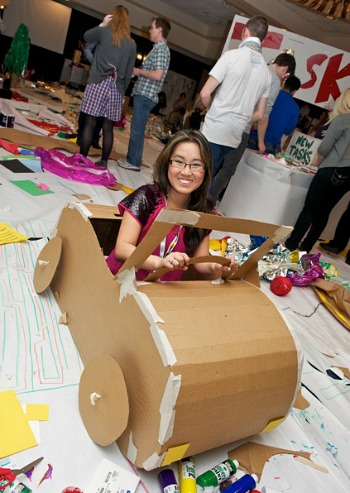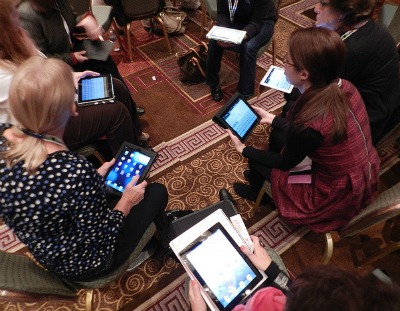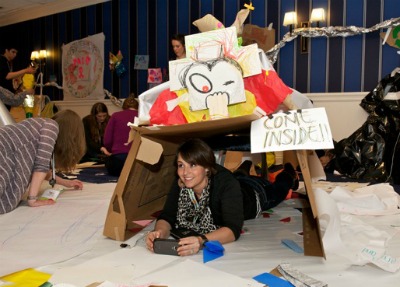School librarian Melissa Techman attended NAEA in New York and gleaned some great art-infused ideas for the classroom and media center
By Melissa Techman
The annual conference of the National Art Education Association (NAEA) featured hands-on fun, resource sharing, and thoughtful discussion on harnessing the power of art to enrich all disciplines.

©2012 Seth & Laura Freeman www.sethfreemanphotography.com
Just like librarians, art teachers view themselves as interdisciplinary instructional leaders who support critical thinking and help students acquire knowledge that’s often neglected in a “teach-to-the-test” world. So it’s not surprising that the conference, held March 1–4 in New York, offered real value to librarians and media specialists.
John Maeda, President of the Rhode Island School of Design talked about cultivating innovation and the critical role of art in his keynote presentation. Maeda is known globally for his push to add art and turn STEM (science, technology, engineering, and mathematics) into STEAM. Maeda insisted that as we fund STEM courses and magnet schools, they must include art and design if they’re to truly fuel innovation.
Museum educators met to share programs to entice and involve young users. Ryan Hill from the Smithsonian’s Hirshhorn Gallery showed how their Digital Learning Lab has become a place for teens to hang out and make audiovisual projects. Staff from other museums discussed the need for more hands-on events to serve all ages. Well-known artist Oliver Herring presided over an open-ended collaborative art party called TASK, in which conference goers and families used donated materials to make whatever their task card required and make up new creative tasks for others. Herring has helped to launch TASK parties at many public spaces, including the Seattle Public Library.
Here are some ways to borrow from art educators’ toolkits:
- Get more art in the schools by helping one of your schools or local public library branches to become an affiliate of the National Gallery of Art. Affiliates can own and freely circulate 125 packets on various topics. Each holds DVDs of video programs, CDs of images and games, as well as print reproductions.
- Learn more about iPads. They were everywhere at NAEA 2012 and art teachers have tested the water thoroughly when it comes to teaching creative uses. A presentation by Tricia Fuglestad and Suzanne Tiedemann covered iPad management and teaching tips that will inform implementation in schools and libraries. See their site for useful ideas to manage teacher and student project workflows. One resource they shared was this short list of digital storytelling apps from Karen Bosch’s iPad Multimedia Tools for Creativity site. See also Theresa McGee’s Collaborative Pinterest board of apps. It contains apps for many purposes, as well as add-ons for iPads and links to other app collections. For example, this “pin”showcases how to use Audioboo to record a student’s voice, attach an image and convert the end result to a QR code.

iPads all around at NAEA. Photo by Craig Roland
- Host a modified library-focused version of a TASK party. Instead of an improvisational art and performance activity, invite students to participate in a learning-centered party. Create boxes labeled “Tasks” and “Completed Tasks.” Explain the process, brainstorming as a group what kind of tasks students could invent. Seed the first box with creative task cards; these could range from “make a newspaper that a creature in David Weisner’s book Flotsam might read” to “grab a Flip camera and get someone to video you acting out two words and their antonyms.” After completing their task, have students create a new task card. Have art and writing supplies, cameras, devices and be sure to have a student team document the fun.
- Riff on the Flat Stanley idea. Samantha Melvin, 2012 Elementary Art Teacher of the Year, involved her whole school in a project for peace in which students made pinwheels, gave them away and then tracked their progress on maps. Samantha suggested adding a message from each student in a small QR code on the pinwheel, including your contact email and location, so students can see whose pinwheel went where.
- Try Stixy.com as a collaboration or planning tool with students or colleagues. Check out Theresa McGee’s video tutorial from the YouTube channel associated with her blog, The Teaching Palette.
- Offer to support a year-long Gaming Dojo club (middle school and up). Ryan Patton of Virginia Commonwealth University’s art department has a wealth of materials for teaching gaming starting at page 181 of his dissertation. Share these tutorials with others in your school community (parents, too) who could teach and learn together. See some examples from teacher Carl Anderson’s seventh-grade game design students.
- Have students make how-to cards for using technology, research tools, and cool projects. See link above for Patton’s Game cards, starting on page 220 of the appendix and teach students how to insert helpful screenshots.
- Co-teach a social media-based quote card project. See Facebook Cards from high school students in Ian Sands’ art class in Apex, NC; “That awkward moment when your bunny burps…”
- Offer to work with teachers on short presentations in a new way. Have students make five-slide Powerpoints on any curricular topic, upload to Slideshare and then use bit.ly to make a QR code from the Slideshare URL. All you need to do is add .qr to the end of the shortened URL bit.ly produces.

©2012 Seth & Laura Freeman www.sethfreemanphotography.com
About the author: Melissa Techman is a school librarian at Broadus Wood Elementary School in Albemarle County, Virginia.



Broken link on the Patton dissertation – try this:
https://etda.libraries.psu.edu/paper/12075/7918
My book, Art in Story (published by ABC-CLIO) utilizes something children of all ages love – story – to introduce them to great artists and art periods in both the Eastern and Western worlds. The different chapters illustrate how art can become integrated throughout the curriculum in all subject areas and include extensive teaching suggestions and bibliographies of related children’s books. Many teachers, especially those in schools where there is no formal art program, have found it useful.